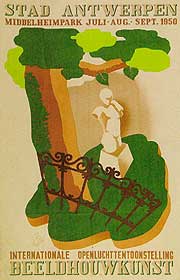"Open-Air
Museum of Sculpture Middelheim" -
![]()
from
Rodin to the present day
Intention:
Beginning with sculptures of Auguste
Rodin, Aristide Maillot, Raymond Duchamp-Villon
and the like, the Open-Air Museum of Sculpture Middelheim gives a unique overview of more than hundred
years of "modern sculpture" in a close-to-nature surrounding.
The period covered is naturally a great advantage,
since it compromises both modern and contemporary art, which means
that, unlike museums of contemporary art, it can show not only the
fault lines but also the continuity between the artistic movements
of the twentieth century. In fact, confrontational displays of modern
and contemporary art show just how well the two get on together,
as exemplified by exhibitions of work by Wim Delvoye (1997), Jessica
Stockholder (1998), Timm Ulrichs (2001) and others. And it is not
only the collection that has reacted positively to newcomers; the
old park, too, has readily adapted over the decades.
In addition:
Open-Air Museum of Sculpture Middelheim is a place for everyone. Not
only art experts but all visitors, families, disabled, blind people
have the possibility to make "their" access to sculptural
art in their individualistic way, according to their wishes. A large
spectrum of public activities, guided tours, workshops for children
and programs for elderly people create a new and easy interaction
with art and nature.
Origin
- development:
Since
its foundation Open-Air Museum of Sculpture Middelheim has come
a long way and the museum scene in Flanders has also seen some major
changes.
From 1950 to 1989 a total
of 20 biennales were held at Middelheim-Laag. The museum usually
purchased several pieces for the permanent collection. After several
decades, Middelheim-Hoog contained about 300 works of art - Belgian artists are naturally well presented. For
various reasons a new policy seemed to be needed and new directions in
terms of content, structure and finance were introduced. In addition, the including
of the wooded areas to the grassland led to a rearrangement of the
permanent collection.

Since Antwerp became the
"Cultural Capital of
Europe" in 1993, the museum's acquisition policy decided that
the contemporary art works of the nineties should be erected in
the park area formerly used for the biennales. Individual exhibitions
presented expansively the work of international artists like Guillaume
Bijl, Tony Cragg, Franz West and Joep van Lieshout, to name but
a few.
A second type of exhibition presented more classical artists
like Henry Moore, Antony Caro and Per Kirkeby.
Thirdly, more experimental exhibitions
are held which do not lead directly to a
purchase and where the artist is therefore free to develop installations
without considering durability and future conservation.
As
it entered the new millennium, Middle museum was given several
opportunities to develop and professionalise its activities.
The
park gained an extra seven hectares, a storage depot, more staff
and more generous financing. Two buildings were constructed, additional
art historians could be employed.
A number of landmarks will
be added to give the park more structure and to make it attractive
even when no temporary exhibitions are beeing held.
The documentation center attracts
not only specialists and insiders, but also the 'ordinary' museum visitor. In 1976, on the death of the Museum's initiator, it was named the "Documentation
Centre Mayor Lode Craeybeckx".
The centre collects and provides information on modern and contemporary
art - from Rodin to the present. It is not limited to artists and sculptures, but also includes general works on modern art, monographs,
catalogues of individual artists' and group exhibitions, collection and
auction catalogues, magazines on modern art, yearbooks, posters, photos,
slides, films and videos.